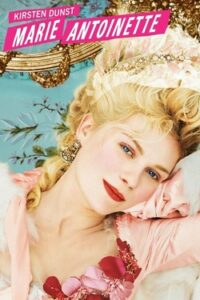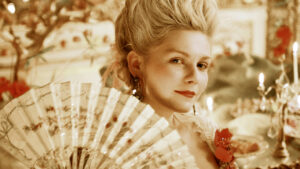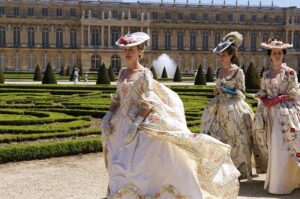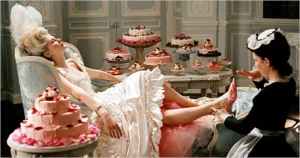“Marie Antoinette” – Rococo Portrait Girl

Title: “Marie Antoinette”
Release Date: 2006
Director: Sofia Coppola
Cast: Kirsten Dunst, Rose Byrne, Jamie Dornan, Judy Davis, Jason Schwartzman, Tom Hardy, Asia Argento
“Marie Antoinette,” directed by Sofia Coppola, is not so much a story about a ruler known from history, as an attempt to draw an intimate, rococo-style portrait of a woman who did not choose her public role, but was fitted into it. The film is thus a vibrant, colorful and sumptuous depiction of a woman’s privacy functioning away from big politics. Kirsten Dunst plays Marie Antoinette from before the French Revolution, and we watch her in the boudoir space, in the maze of Versailles gardens and behind the walls of royal palaces.
“Marie Antoinette” and the story of her Versailles life
“Marie Antoinette” shows a slice of the life of the famous French queen, wife of Louis XVI, executed with him on the guillotine in 1793. Namely, Sofia Coppola depicts the period from the arrival of the Dauphine in France until she left Versailles after the outbreak of the Great French Revolution. Here, fourteen-year-old Marie (played by Kirsten Dunst), who comes from the Austrian Habsburg dynasty, is married off to Louis Augustus (Jason Schwartzman), grandson of French King Louis XV. The girl arrives in the country with her ladies of the court and her beloved puppy, but at the very beginning, according to French custom, she has to abandon everything that binds her to her previous life.
This is the first moment when the vivacious and girlish temperament girl has to face the incomprehensible rigid conventions. Subsequent customs, such as the public preparations for the wedding night, the dressing ceremony and childbirth in the presence of the entire court will leave her completely bewildered. After the death of her grandfather, Marie Antoinette’s husband becomes King of France and she herself becomes Queen, trying to fulfill her primary task, which is to give birth as soon as possible to a son that will strengthen the alliance of the two dynasties.

This, nonetheless, proves very difficult, as for the first seven years her marriage to Louis XVI remains unconsummated. All the blame unfairly falls on Marie Antoinette, but eventually, thanks to a minor surgical procedure correcting the king’s defect, a daughter is born, followed by a coveted son and two more children. Life at Versailles goes on with its own rhythm, marked by games, balls, philosophical disputes and performances, until the outbreak of the Revolution.
“Marie Antoinette” – a contemporary teenager in a rococo dress
Sofia Coppola shows Marie Antoinette not through the prism of her political and historical role, but as a very young and inexperienced woman who wants to escape the heavy and foreign mold imposed on her at all costs. This is phenomenally shown in the scene of the heroine’s arrival in France, when she is completely transformed before the viewer’s eyes by a staff of etiquette specialists led by the Marquise Dufort. From an ordinary, vivacious fourteen-year-old in childish attire, she becomes a stiff-faced lady, struggling to navigate her new closet. The viewer, however, knows that under this artificial superficiality lies a cheerful girl, thirsty for fun and entertainment.
And this is exactly how Marie Antoinette is most often portrayed here: running around the chambers, gossiping with her friends, laughing and partying until dawn. The queen appears as an ordinary teenager, with temperament and interests typical of that age. Her greatest passions are clothes, shoes, perfumes and trinkets, which she passionately imports from all over the world. The young queen is busy designing her garden, visiting the theater and going to masquerade balls at night. Her thoughts are also occupied by handsome Swedish aristocrat Hans Axel von Fersen (Jamie Dornan), with whom she strikes up a secret love affair.
The image of Marie Antoinette is drawn in a remarkably contemporary way, as indicated by a number of structural elements of the film. Significant already is the introductory scene in which the heroine philutinously winks at the viewer, and this direct establishment of eye contact with the viewer is repeated several times throughout the plot. An important role is also played by the soundtrack, which includes a number of modern post-punk songs that provide a commentary on the queen’s youthful antics. Thanks to these treatments, the character of Marie Antoinette acquires modern features and becomes closer to the viewer.

Sofia Coppola often expresses in her works her interest in precisely this stage of women’s lives: on the threshold of maturity, in a yet unformed and unpasteurized form. The same is true in “The Virgin Suicides” (1999), “Lost in translation” (2003) or “The Beguiled” (2017). The director creates images of girls who have not yet tasted “life wisdom”, look at reality with youthful curiosity and for whom any scenario is possible. It is no coincidence that “Marie Antoinette” ends before the queen reaches the Tuileries palace and then the Temple tower. For this is not a film about a dethroned, humiliated ruler put to death on a guillotine, but about a girl loving life and taking full advantage of it. This contrast between the ominous shadow of tragedy weighing down on Marie Antoinette and Coppola’s incredibly bright vision, full of bright pink and blue, is also extremely significant.
The movie “Marie Antoinette” – an escape from convention
The previously mentioned signals of establishing a direct relationship between the heroine and the viewer also perform another function in the film: namely, they expose the illusion of the presented world. We have the impression that Kirsten Dunst creates a character constantly distanced from the role imposed on her: just as the actress plays it in front of the viewer, so her heroine gives a performance for her surroundings. She is not so much a queen as she impersonates one at important ceremonies and official occasions. What’s more, she excels at it, gradually learning the rules of the court and maturing as a woman and mother. By the end of the film, however, there is no full identification of Marie Antoinette-the ruler-with the person behind the role. The character known from the history books will be born only later, during the gehenna of imprisonment, humiliation and suffering.
Instead, the viewer watches a heroine who consistently avoids confinement in her destined world. The ruler is not interested in politics, she treats with indulgence the admonitions of the advisor sent to her by her mother, Empress Maria Theresa, and during the ceremony of decorating French officers she puts garlands of flowers she has just braided in the garden on their heads. However, she will not escape her destiny, whose ominous signs discreetly appear in the film. These are the highly symbolic shots of the queen on the balcony of one of Versailles’ castles – when she appears to be just a small point against the heavy building. There are also repeated images of Marie Antoinette on the grand staircase of Versailles – like an insignificant, helpless figure in the arena of history.

Sofia Coppola’s movie also did not lack the motif most associated with the figure of the French ruler – the famous cakes. Images of cakes, iced cookies and various sweets are a kind of leitmotiv of “Marie Antoinette“. Sweets accompany the queen in almost every circumstance: she eats them while trying on costumes, treats her friends at dinners and balls, always has them in her boudoir, and servants constantly replenish the disappearing baked goods in a flash. And although she herself denies the rumor that she would recommend her hungry people to eat cakes, similar words in her mouth seem very likely, but at the same time innocent in their own way. For they are uttered by a person completely isolated from the ordinary world, whose entire adult life has passed in the pentagram of Versailles castles, amidst luxuries, champagne and sweets.
“Marie Antoinette” – the rococo queen
“Marie Antoinette” is not an in-depth biographical or historical study, but it certainly wonderfully captures the atmosphere of the era, and above all the Rococo. It is it that reigns on the screen in every possible sense. We see magnificently reconstructed Rococo interiors, vibrantly colored costumes and boudoirs, fancy hairstyles, and hear music from clavichords. It’s also a lifestyle: a love of fun, pleasure and entertainment, expressed in frequent parties, balls, games and feasts. The queen’s chambers are filled with beautiful miniatures, mirrors and fancy oriental trinkets, like the porcelain given to her by the Emperor of China.
There were also elements of sentimentalism, the basic philosophy of the trend. Thus, Marie Antoinette, along with her ladies of the court, read in the works of Johann Jacques Rousseau postulating the return of man to nature. In accordance with these recommendations, the queen and her children therefore spend time in picturesque gazebos, observing animal life, lounging on the grass and even collecting eggs in the henhouse and feeding the fowl with her own hands. It was not without reason that the French ruler was called the Queen of Rococo. And it was an incredibly feminine style, glorifying the intimate world of the cozy boudoir, tiny trinkets and candy canes. And that’s what Sofia Coppola’s film is, too – mimicking the style of the Rococo portrait in which we see its main character, Marie Antoinette.
Literature:
A.Helman, „Sofia Coppola – w stronę zakwitających dziewcząt”, [w:] „Mistrzowie kina amerykańskiego”, Kraków 2010.
